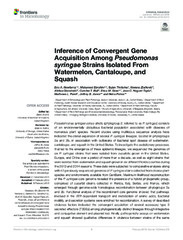Приказ основних података о документу
Inference of Convergent Gene Acquisition Among Pseudomonas syringae Strains Isolated From Watermelon, Cantaloupe, and Squash
| dc.creator | Newberry, Eric | |
| dc.creator | Ebrahim, Mohamed | |
| dc.creator | Timilsina, Sujan | |
| dc.creator | Zlatković, Nevena | |
| dc.creator | Obradović, Aleksa | |
| dc.creator | Bull, Carolee | |
| dc.creator | Goss, Erica | |
| dc.creator | Huguet Tapia, Jose | |
| dc.creator | Paret, Mathews | |
| dc.creator | Jones, Jeffrey | |
| dc.creator | Potnis, Neha | |
| dc.date.accessioned | 2023-09-20T11:32:14Z | |
| dc.date.available | 2023-09-20T11:32:14Z | |
| dc.date.issued | 2019 | |
| dc.identifier.issn | 1664-302X | |
| dc.identifier.uri | https://plantarum.izbis.bg.ac.rs/handle/123456789/960 | |
| dc.description.abstract | Pseudomonas syringae sensu strict , (phylogroup 2; referred to as P. syringae) consists of an environmentally ubiquitous bacterial population associated with diseases of numerous plant species. Recent studies using multilocus sequence analysis have indicated the clonal expansion of several P. syringae lineages, located in phylogroups 2a and 2b, in association with outbreaks of bacterial spot disease of watermelon, cantaloupe, and squash in the United States. To investigate the evolutionary processes that led to the emergence of these epidemic lineages, we sequenced the genomes of six P. syringae strains that were isolated from cucurbits grown in the United States, Europe, and China over a period of more than a decade, as well as eight strains that were isolated from watermelon and squash grown in six different Florida counties during the 2013 and 2014 seasons. These data were subjected to comparative analyses along with 42 previously sequenced genomes of P. syringae stains collected from diverse plant species and environments available from GenBank. Maximum likelihood reconstruction of the P. syringae core genome revealed the presence of a hybrid phylogenetic group, comprised of cucurbit strains collected in Florida, Italy, Serbia, and France, which emerged through genome-wide homologous recombination between phylogroups 2a and 2b. Functional analysis of the recombinant core genome showed that pathways involved in the ATP-dependent transport and metabolism of amino acids, bacterial motility, and secretion systems were enriched for recombination. A survey of described virulence factors indicated the convergent acquisition of several accessory type 3 secreted effectors (T3SEs) among phylogenetically distinct lineages through integrative and conjugative element and plasmid loci. Finally, pathogenicity assays on watermelon and squash showed qualitative differences in virulence between strains of the same clonal lineage, which correlated with T3SEs acquired through various mechanisms of horizontal gene transfer (HGT). This study provides novel insights into the interplay of homologous recombination and HGT toward pathogen emergence and highlights the dynamic nature of P. syringae sensu lato genomes. | sr |
| dc.language.iso | en | sr |
| dc.publisher | Frontiers Media Sa, Lausanne | sr |
| dc.relation | info:eu-repo/grantAgreement/MESTD/Integrated and Interdisciplinary Research (IIR or III)/46008/RS// | sr |
| dc.rights | openAccess | sr |
| dc.rights.uri | https://creativecommons.org/licenses/by/4.0/ | |
| dc.source | Frontiers in Microbiology | sr |
| dc.subject | horizontal gene transfer | sr |
| dc.subject | homologous recombination | sr |
| dc.subject | pathogen emergence | sr |
| dc.subject | Pseudomonas syringae sensu stricto | sr |
| dc.subject | cucurbits | sr |
| dc.title | Inference of Convergent Gene Acquisition Among Pseudomonas syringae Strains Isolated From Watermelon, Cantaloupe, and Squash | sr |
| dc.type | article | sr |
| dc.rights.license | BY | sr |
| dc.citation.epage | 18 | |
| dc.citation.spage | 1 | |
| dc.citation.volume | 10 | |
| dc.type.version | publishedVersion | sr |
| dc.identifier.doi | 10.3389/fmicb.2019.00270 | |
| dc.identifier.fulltext | http://plantarum.izbis.bg.ac.rs/bitstream/id/3298/bitstream_3298.pdf | |
| dc.identifier.pmid | 30837979 | |
| dc.identifier.scopus | 2-s2.0-85065923215 | |
| dc.identifier.wos | 000458953600001 |


